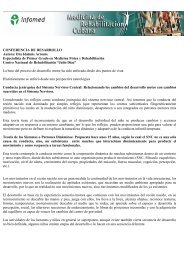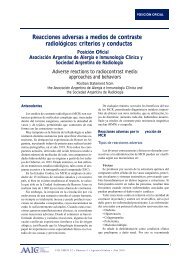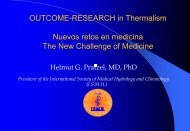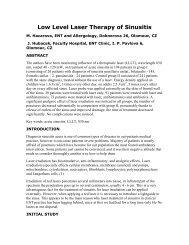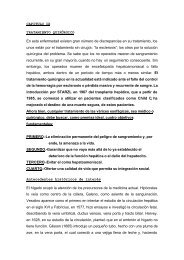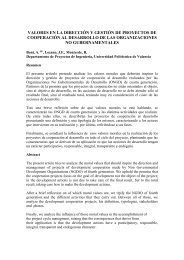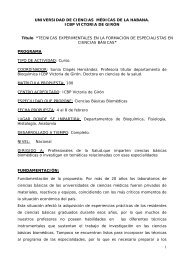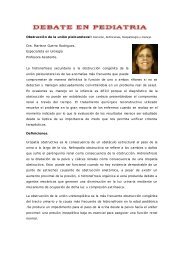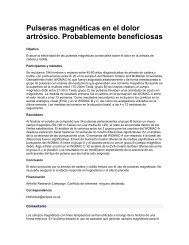Comparison ofthree facebow/semi-adjustable articulator systems for ...
Comparison ofthree facebow/semi-adjustable articulator systems for ...
Comparison ofthree facebow/semi-adjustable articulator systems for ...
Create successful ePaper yourself
Turn your PDF publications into a flip-book with our unique Google optimized e-Paper software.
186 British Journal of Oral and Maxillofacial Surgery<br />
Table 1 – Areas of model surgery facilitated by a <strong>semi</strong>-<strong>adjustable</strong><br />
<strong>articulator</strong><br />
Checking validity of planned bone cuts and magnitude of<br />
movements including autorotation of the mandible;<br />
Practising the osteotomy cuts;<br />
Assessing outcome in terms of dynamic occlusion and<br />
aesthetics;<br />
Construction of intermediate and final interpositional acrylic<br />
wafers to check that surgical movements match planned<br />
movements.<br />
simple-hinge <strong>articulator</strong> (such as the Galetti) as<br />
opposed to a <strong>semi</strong>-<strong>adjustable</strong> type (such as the Hanau)<br />
resulted in an antero-posterior error of 2 mm on the<br />
Galetti and 0.2 mm on the Hanau. 11<br />
Accuracy of model surgery, construction of<br />
splints 13–15 and the <strong>articulator</strong> <strong>systems</strong> (calliper plat<strong>for</strong>m,<br />
16 reverse surgical sequencing 17 ) have all been<br />
described previously. The most cited model surgery<br />
techniques are the ‘Lockwood key-spacer system’ 18 and<br />
‘The Eastman Technique’. 19 Bamber et al. (A comparative<br />
study of two orthognathic model surgery techniques.<br />
Paper presented at the British Society <strong>for</strong><br />
Dental Research, 1996) compared the accuracy of<br />
these two techniques using duplicate casts of 15<br />
patients with different malocclusions requiring Le<br />
Fort I osteotomy planned on the Denar Mark II <strong>articulator</strong>.<br />
They found neither technique to be absolutely<br />
accurate, but the Eastman technique was significantly<br />
better <strong>for</strong> vertical and anteroposterior movements.<br />
Model surgery is subject to discrepancies; significant<br />
differences between planned and surgical jaw<br />
movements can result from the difference between the<br />
true and simulated centres of mandibular rotation as<br />
well as from the erroneous transfer of reference lines<br />
and points between model surgery and operation. 20<br />
The centre of autorotation is likely to be posterior and<br />
inferior to the centre of the condyle, 21 and there<strong>for</strong>e<br />
autorotation is difficult to mimic on an <strong>articulator</strong><br />
that rotates around its metallic condyle and not<br />
around a point posterior and inferior to it.<br />
We aimed to investigate possible differences in<br />
anteroposterior steepness (cant of the occlusal plane)<br />
between three <strong>semi</strong>-<strong>adjustable</strong> <strong>articulator</strong>s, whether<br />
differences in skeletal pattern have any influence on<br />
the steepness of the occlusal plane, and finally<br />
whether these differences affect the surgical planning<br />
<strong>for</strong> maxillary or mandibular osteotomies. Local ethics<br />
committee approval was given.<br />
SUBJECTS AND METHODS<br />
Patients who were to have orthognathic presurgical<br />
assessment were invited to participate in the clinical<br />
study at the Liverpool University Dental Hospital’s<br />
department of orthodontics (Table 3). The inclusion<br />
criteria were patients who required correction of their<br />
skeletal class II or III malocclusion by osteotomy;<br />
either a recent lateral cephalometric radiography (at<br />
beginning or end of presurgical orthodontics) or the<br />
Table 2 – Indications <strong>for</strong> types of <strong>articulator</strong> <strong>for</strong> various osteotomy<br />
procedures 11<br />
Simple-hinge adequate:<br />
• Mandibular advancement, set-back, or subapical surgery;<br />
• Maxillary subapical surgery (where no change in the vertical<br />
plane of space is proposed);<br />
• Maxillary transverse expansion or contraction (subject to the<br />
following constraints):<br />
• Anterior and vertical orientation of the anterior maxilla is<br />
assessed first by cephalometric measurements;<br />
• Feasibility of mandibular autorotation is studied first by<br />
cephalometric measurements;<br />
• Maxillary occlusal plane is not canted appreciably;<br />
• Tripod occlusal stability exists between the maxillary and<br />
mandibular models (no large edentulous spaces will prevent<br />
proper model orientation).<br />
Semi-<strong>adjustable</strong> indicated:<br />
• When the case fails to satisfy any of the constraints listed above;<br />
• Maxillary impaction and mandibular autorotation;<br />
• Fabrication of an intermediate splint;<br />
• To ensure coincidence of dental and facial midlines;<br />
• Mandibulofacial asymmetries;<br />
• When excursions of the proposed occlusion are to be studied.<br />
Table 3 – Study sample group of patients be<strong>for</strong>e orthognathic<br />
procedures<br />
Sex No. of Age (years) Skeletal pattern<br />
patients<br />
Mean (SD) Class II Class III<br />
Male 7 20.9 (6.7) 5 2<br />
Female 13 19.5 (6.6) 5 8<br />
Total 20 20.0 (6.5) 10 10<br />
need <strong>for</strong> a future film <strong>for</strong> surgical planning and there<strong>for</strong>e<br />
no need <strong>for</strong> additional radiography and written<br />
consent.<br />
Patients who had already been operated on, had<br />
facial asymmetry, or who had inadequate clinical<br />
records were excluded. The sample was recruited from<br />
sequential patients taken from the waiting list <strong>for</strong><br />
treatment, or from those attending orthognathic planning<br />
clinics at the end of presurgical orthodontics,<br />
and had, by definition, severe skeletal class II or III<br />
de<strong>for</strong>mities.<br />
The three <strong>facebow</strong>s studied were the Denatus type<br />
ARL (Denatus International, Hagersten, Sweden),<br />
the Denar Mask II (Denar Corporation, Anaheim,<br />
Cali<strong>for</strong>nia, USA), and the Whipmix Quickmount<br />
8800 (Whipmix, Louisville, Kentucky, USA). Each<br />
<strong>facebow</strong> was registered in turn according to the manufacturer’s<br />
instructions. The operator (AO’M) was<br />
trained in all three types by an experienced restorative<br />
dentist (AM) to ensure that his technique was correct.<br />
All records <strong>for</strong> each subject were completed on the<br />
same day by the same operator.<br />
Each <strong>facebow</strong> was mounted on to its respective<br />
<strong>articulator</strong>, which was placed on an optically levelled<br />
plat<strong>for</strong>m. This was done by placing two bubble gauges<br />
at right angles to each other, ensuring that the <strong>articulator</strong><br />
base (lower arm) and upper arm were parallel<br />
with the true horizontal. This allowed measurement<br />
of the maxillary occlusal plane angle by putting the




